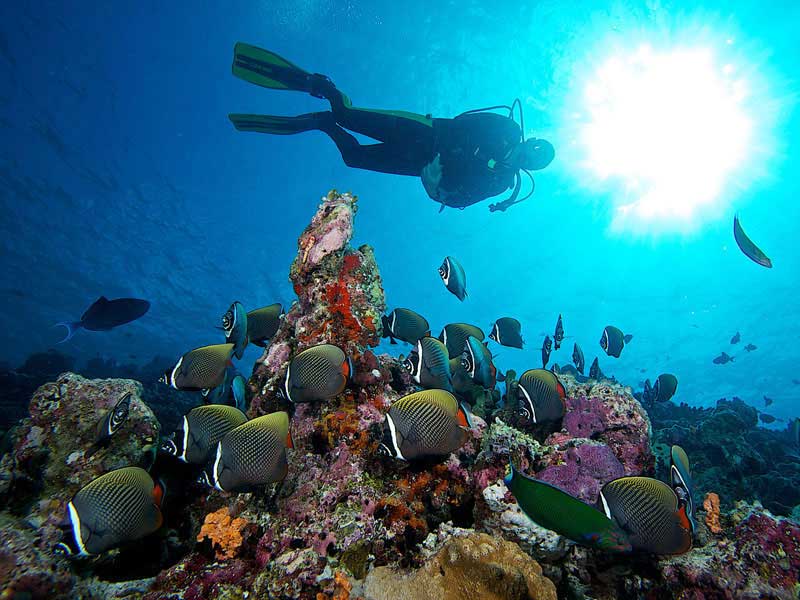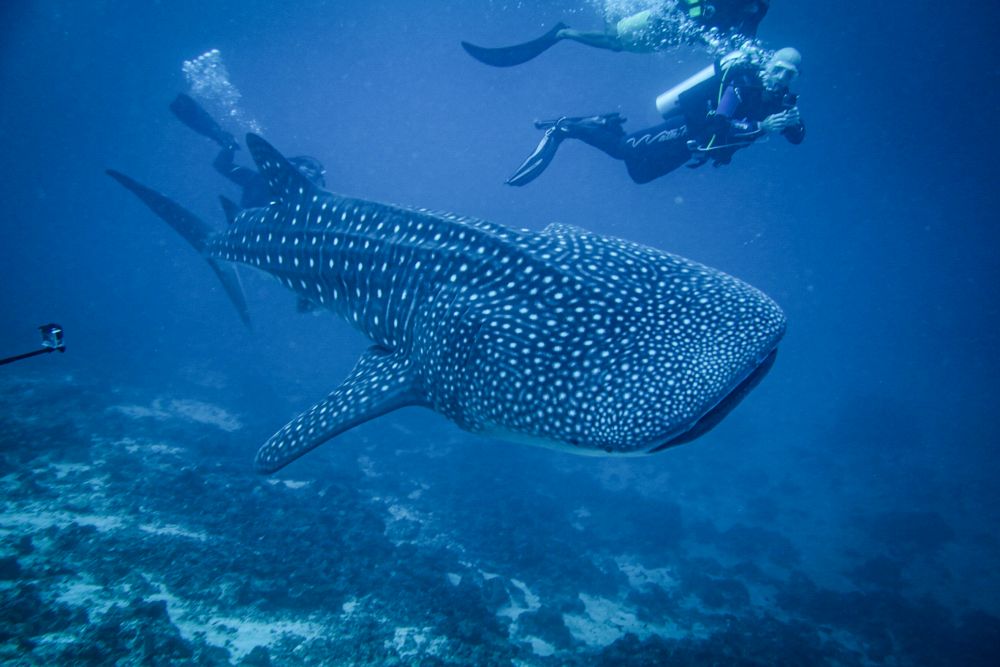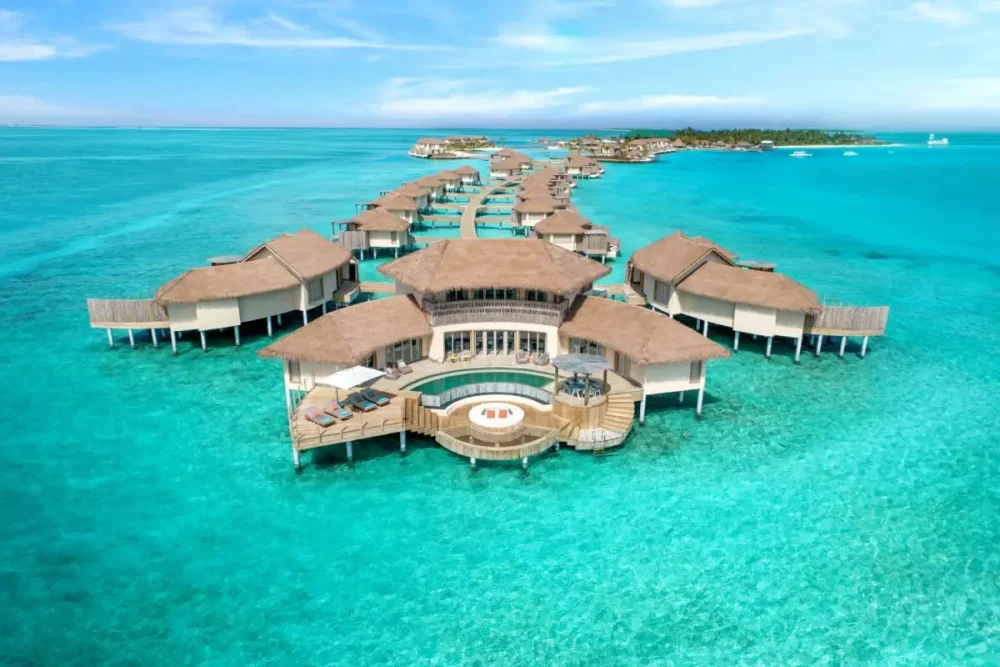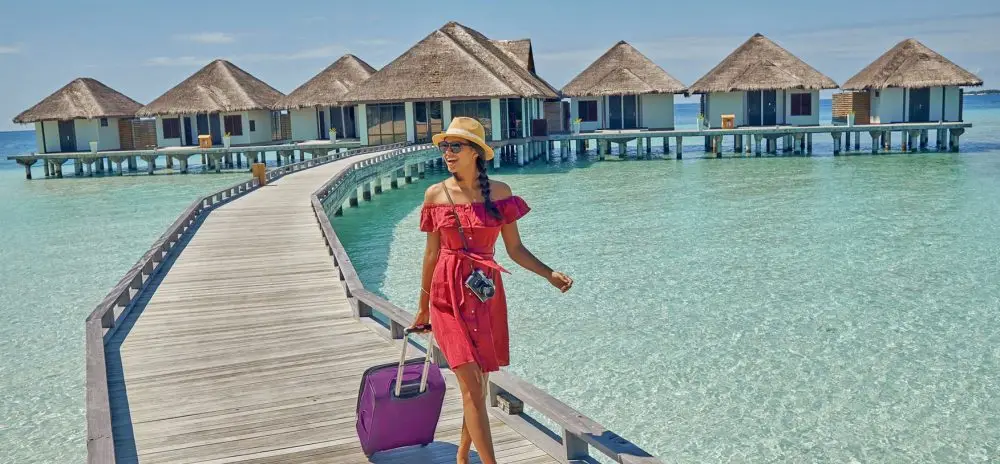Die Malediven sind ein Paradies für Unterwasserfans. Malerische Atolle und eine reiche Artenvielfalt machen die Inseln zu einem der beliebtesten Ziele für Taucher. Die farbenfrohe Unterwasserwelt zieht Schwimmer aller Könnensstufen an und die Flora und Fauna schafft ideale Tauchbedingungen. Im Jahr 2025 gilt das Tauchen auf den Malediven als eines der aufregendsten Erlebnisse für Reisende.

Tauchsaison auf den Malediven
Tauchen auf den Malediven ist das ganze Jahr über möglich, aber die besten Tauchbedingungen herrschen zwischen November und April. Dies gilt als die Jahreszeit der trockenen und sonnigen Tage, in der die Niederschläge minimal sind und die Sicht im Wasser am besten ist:
- Die Trockenzeit (November bis April) ist die beste Zeit. In dieser Zeit ist das Wasser warm, die Lufttemperatur liegt zwischen 25 und 30 Grad Celsius und die Sicht unter Wasser beträgt 30 Meter oder mehr. Sie können kristallklares Wasser genießen und Meeresbewohner wie Muränen, Delfine und Riesenschildkröten beobachten.
- Regenzeit (Mai – Oktober) – obwohl die Regenzeit eine höhere Luftfeuchtigkeit und häufige kurzfristige Regenfälle mit sich bringt, ist das Tauchen immer noch möglich. Die Sicht kann etwas schlechter sein, und die Kosten für Touren und Hotels sind niedriger, was für preisbewusste Reisende attraktiv ist.
Die besten Tauchatolle auf den Malediven
 Die Malediven sind in 26 Atolle unterteilt, von denen jedes seine eigenen Besonderheiten hat und Taucher mit besonderen Bedingungen anzieht. Werfen wir einen Blick auf ein paar der beliebtesten Inseln, die man besuchen kann:
Die Malediven sind in 26 Atolle unterteilt, von denen jedes seine eigenen Besonderheiten hat und Taucher mit besonderen Bedingungen anzieht. Werfen wir einen Blick auf ein paar der beliebtesten Inseln, die man besuchen kann:
- Das Ari-Atoll ist bekannt für seine spektakulären Riffe und sein reiches Meeresleben. Schildkröten, Delfine und riesige Stachelrochen sind hier zu finden. Besonders berühmt ist das Atoll für die Möglichkeit, Walhaie, die größten Fische der Welt, zu sehen.
- Das Baa-Atoll ist bekannt für sein Ökosystem und sein reiches Meeresleben. Fischarten wie Kugelfische sind hier ebenso zu finden wie Muränen und eine Vielzahl von Schildkröten. Dieser Ort ist besonders attraktiv für diejenigen, die in mittlerer Tiefe tauchen möchten, wo Korallen ungewöhnliche Unterwasserlandschaften bilden.
- Süd-Male ist nicht nur als Tauchrevier bekannt, sondern auch als ein großartiger Ort für Tauchsafaris. Mantarochen sind hier ebenso zu sehen wie riesige Schwärme von Soldatenfischen und verschiedene Haie.
- Nord-Male” ist ein berühmter Ort für professionelles Tauchen. Die Tiefen können hier über 30 Meter erreichen und das Wasser ist kristallklar. Riffhaie schwimmen hier oft auf der Suche nach Nahrung, was das Tauchen noch spannender macht.
Meeresleben auf den Malediven: Was ein Taucher antreffen kann
Tauchen auf den Malediven bietet Zugang zu einer der intensivsten Unterwasserwelten des Indischen Ozeans. Die Riffe sind die Heimat von Hunderten von Arten, darunter sowohl kleine als auch große Arten. Dazu gehören:
- Riffhaie sind graue, Weißspitzen- und Schwarzspitzenhaie. Sie schwimmen in der Nähe von Kanälen und Riffen und sind nicht aggressiv, aber es ist besser, sich von ihnen fernzuhalten.
- Walhaie – sie werden bis zu 12-18 Meter lang. Von Mai bis November häufig vor dem Süd-Ari-Atoll zu sehen.
- Manta-Rochen – besonders aktiv in Baa von Juli bis Oktober. Flügelspannweite bis zu 7 m.
- Grüne Schildkröten und Bissa (Echte Karettschildkröten) – in der Nähe von Hausriffen und tiefen Lagunen zu finden. Die Bewohner fressen oft direkt vor den Augen der Taucher.
- Muränen, Clownfische, Napoleons, Barrakudas – das schafft visuelle Dichte und macht jeden Tauchgang zu einem intensiven Erlebnis.
Tauchpreise auf den Malediven im Jahr 2025: Was Sie wissen müssen
Tauchen auf den Malediven ist nach wie vor einer der beliebtesten Urlaube für Unterwasserfans. Die Malediven sind ein Taucherparadies, in dem man erstaunliche Riffe, exotische Meeresbewohner und Unterwasserlandschaften erleben kann. Bevor man in diese faszinierende Welt eintaucht, sollte man sich darüber im Klaren sein, welche Kosten auf den Touristen zukommen.
Tauchausbildung auf den Malediven
Für diejenigen, die gerade erst ihre Reise in die Unterwasserwelt beginnen, ist die Ausbildung ein wesentlicher Bestandteil des Prozesses. Auf den Malediven werden mehrere Anfängerkurse angeboten, der beliebteste ist der PADI Open Water Course. Das Programm ermöglicht es Ihnen, ein zertifizierter Taucher zu werden und ein internationales Zertifikat zu erwerben, das Ihnen die Möglichkeit eröffnet, rund um die Welt zu tauchen. Der PADI-Kurs umfasst sowohl theoretischen Unterricht als auch praktische Tauchgänge im offenen Meer unter der Leitung eines Tauchlehrers.
Preise:
- Kosten: 350 bis 450 USD.
- Was der Kurs beinhaltet: Ausbildungsmaterial, Tauchausrüstung, theoretischer Unterricht, praktische Tauchgänge (normalerweise 4-5 Tauchgänge im offenen Meer) und Zertifizierung am Ende des Kurses.
Die Kosten können je nach Resort oder Tauchbasis sowie der Jahreszeit variieren. In der Hochsaison (Dezember bis April) sind die Preise zum Beispiel etwas höher, da die Nachfrage nach Dienstleistungen steigt.
Tauchausrüstung auf den Malediven mieten
Die Ausrüstungsmiete ist eine der größten Ausgaben für diejenigen, die tauchen wollen, aber keine eigene Ausrüstung haben. Viele Tauchzentren bieten alle notwendigen Ausrüstungsgegenstände wie Maske, Schnorchel, Flossen, Neoprenanzug und Sauerstoffflasche an.
Kosten:
- Mietpreis der Ausrüstung: von 25 bis 40 USD pro Tag.
- Im Mietpreis inbegriffen: eine komplette Tauchausrüstung (Maske, Schnorchel, Flossen, Flasche und Neoprenanzug). In einigen Fällen ist es möglich, nur einen Teil der Ausrüstung zu mieten, wenn der Tourist zum Beispiel bereits seine eigenen Flossen oder Maske hat.
- Was den Preis beeinflusst: Qualität und Marke der Ausrüstung, Saisonabhängigkeit und Verfügbarkeit von Sonderangeboten der Tauchbasis.
Wenn Sie vorhaben, mehrere Tauchgänge zu machen oder in verschiedene Gebiete zu reisen, ist das Mieten von Ausrüstung eine praktische Option. Einige Hotels haben Tauchzentren mit eigenen Stränden, und die Ausrüstung ist für Gäste kostenlos.
Tauchsafaris auf den Malediven
Tauchsafaris sind eine der aufregendsten Möglichkeiten, die Unterwasserwelt der Inseln zu erkunden. Das Tauchen auf verschiedenen Atollen, die Fahrt auf speziell ausgerüsteten Schiffen und die Möglichkeit, an einem Tag an mehreren Orten zu tauchen, ist ein unvergessliches Erlebnis für den abenteuerlustigen Reisenden.
Kosten:
- Preis: von 500 bis 1.000 USD pro Woche.
-
Im Preis inbegriffen sind: Unterkunft auf dem Boot, mehrere Tauchgänge pro Tag, alle notwendigen Dienstleistungen (einschließlich Verpflegung, Ausrüstung, Tauchlehrer und Führer). Während der Safari besuchen die Taucher die berühmtesten und abgelegensten Atolle der Malediven mit einzigartigen Korallengärten und Unterwasserleben. Dies ermöglicht bis zu 4 Tauchgänge pro Tag, wodurch das Format ideal für erfahrene Taucher ist.

Schlussfolgerung
 Tauchen auf den Malediven ist ein unvergessliches Erlebnis, das ein Leben lang lebendige Eindrücke hinterlassen wird. Die vielen besonderen Fischarten, atemberaubenden Korallenriffe und atemberaubenden Unterwasserlandschaften schaffen die perfekte Tauchumgebung. Im Jahr 2025 sind die Malediven nach wie vor eines der attraktivsten Reiseziele für Tauchbegeisterte und es ist für jeden etwas dabei.
Tauchen auf den Malediven ist ein unvergessliches Erlebnis, das ein Leben lang lebendige Eindrücke hinterlassen wird. Die vielen besonderen Fischarten, atemberaubenden Korallenriffe und atemberaubenden Unterwasserlandschaften schaffen die perfekte Tauchumgebung. Im Jahr 2025 sind die Malediven nach wie vor eines der attraktivsten Reiseziele für Tauchbegeisterte und es ist für jeden etwas dabei.
 en
en  ar
ar  de
de  es
es  fr
fr  nl
nl  hi
hi  it
it  pt
pt  el
el 



